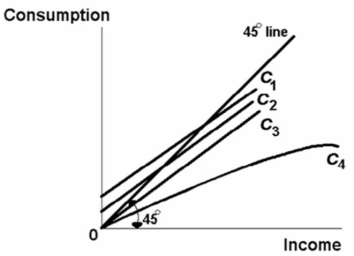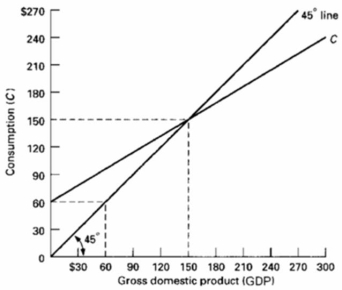A) households will consume three-fourths of whatever level of disposable income they receive.
B) households will consume $35 if their disposable income is zero and will consume three-fourths of any increase in disposable income they receive.
C) there is an inverse relationship between disposable income and consumption.
D) households will save $35 if their disposable income is zero and will consume three-fourths of any increase in disposable income they receive.
Correct Answer

verified
Correct Answer
verified
Multiple Choice
If the saving schedule is a straight line, the:
A) MPS must be constant.
B) APS must be constant.
C) APC must be constant.
D) MPC must be rising.
Correct Answer

verified
Correct Answer
verified
Multiple Choice
The simple multiplier is:
A) 1/MPC.
B) 1/(1 + MPC) .
C) 1/MPS.
D) 1/(1 - MPS) .
Correct Answer

verified
Correct Answer
verified
True/False
The wealth effect will tend to decrease consumption and increase saving.
Correct Answer

verified
Correct Answer
verified
Multiple Choice
 Refer to the above diagram.The MPC and APC are both constant as income increases for:
Refer to the above diagram.The MPC and APC are both constant as income increases for:
A) none of the consumption schedules shown.
B) C3 only.
C) C3 and C4 only.
D) C1 and C2 only.
Correct Answer

verified
Correct Answer
verified
Multiple Choice
The consumption schedule relates:
A) consumption to the level of disposable income.
B) saving to the level of disposable income.
C) disposable income to domestic income.
D) consumption to saving.
Correct Answer

verified
Correct Answer
verified
Multiple Choice
If the nominal interest rate is 18 percent and the real interest rate is 6 percent, the inflation rate is:
A) 18 percent.
B) 24 percent.
C) 12 percent.
D) 6 percent.
Correct Answer

verified
Correct Answer
verified
Multiple Choice
The multiplier:
A) varies directly with the slope of the investment-demand schedule.
B) is unrelated to the slope of the saving schedule.
C) will be greater, the smaller the slope of the saving schedule.
D) will be greater, the steeper the slope of the saving schedule.
Correct Answer

verified
Correct Answer
verified
Multiple Choice
The investment-demand curve will shift to the left:
A) if firms plan to increase their inventories.
B) if firms plan to decrease their inventories.
C) if firms expect an increase in their sales.
D) if firms expect no change in their sales.
Correct Answer

verified
Correct Answer
verified
Multiple Choice
Assume that for the entire business sector of the economy there is $0 worth of investment projects which will yield an expected rate of return of 25 percent or more.But there are $15 worth of investments which will yield an expected rate of return of 20-25 percent; another $15 with an expected rate of return of 15-20 percent; and similarly an additional $15 of investment projects in each successive rate of return range down to and including the 0-5 percent range.Refer to the above information.If the real interest rate is 15 percent, what amount of investment will be undertaken?
A) $15
B) $30
C) $45
D) $60
Correct Answer

verified
Correct Answer
verified
Multiple Choice
Suppose that the level of GDP increased by $100 billion in an economy where the marginal propensity to consume is 0.5.The initial change in spending must have been:
A) $100 billion.
B) $50 billion.
C) $500 billion.
D) $5 billion.
Correct Answer

verified
Correct Answer
verified
Multiple Choice
Which of the following is correct?
A) MPC + MPS = APC + APS
B) APC + MPS = APS + MPC
C) APC + MPC = APS + MPS
D) APC - APS = MPC - MPS
Correct Answer

verified
Correct Answer
verified
Multiple Choice
Which one of the following will cause a movement down along an economy's consumption schedule?
A) an increase in stock prices
B) a decrease in stock prices
C) an increase in consumer indebtedness
D) a decrease in disposable income
Correct Answer

verified
Correct Answer
verified
Multiple Choice
Following is consumption schedules for three private closed economies.DI signifies disposable income and C represents consumption expenditures.All figures are in billions of dollars.  Refer to the above data.The marginal propensity to consume:
Refer to the above data.The marginal propensity to consume:
A) is highest in economy (1) .
B) is highest in economy (3) .
C) is highest in economy (2) .
D) cannot be calculated from the data given.
Correct Answer

verified
Correct Answer
verified
Multiple Choice
 Refer to the above diagram.The equation for the saving schedule is:
Refer to the above diagram.The equation for the saving schedule is:
A) S = .6Y.
B) Y = 60 + .6S.
C) S = 60 + .4Y.
D) S = -60 + .4Y.
Correct Answer

verified
Correct Answer
verified
True/False
Economists disagree on the actual size of the multiplier.
Correct Answer

verified
Correct Answer
verified
Multiple Choice
The investment-demand curve will shift to the right as the result of:
A) the availability of excess productive capacity.
B) an increase in business taxes.
C) businesses becoming more optimistic with respect to future business conditions.
D) an increase in the real interest rate.
Correct Answer

verified
Correct Answer
verified
Multiple Choice
With an MPS of .4, the MPC will be:
A) 1.0 minus .4.
B) .4 minus 1.0.
C) the reciprocal of the MPS.
D) .4.
Correct Answer

verified
Correct Answer
verified
Multiple Choice
Other things equal, a 10 percent decrease in corporate income taxes will:
A) decrease the market price of real capital goods.
B) have no effect on the location of the investment-demand curve.
C) shift the investment-demand curve to the right.
D) shift the investment-demand curve to the left.
Correct Answer

verified
Correct Answer
verified
Multiple Choice
The simple multiplier may be calculated as:
A) 1/(MPS + MPC) .
B) 1/(1 - MPC) .
C) MPC/MPS.
D) 1 - MPC = MPS.
Correct Answer

verified
Correct Answer
verified
Showing 121 - 140 of 200
Related Exams